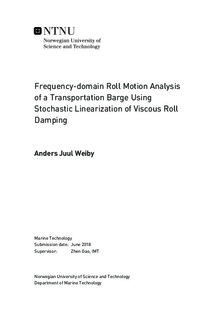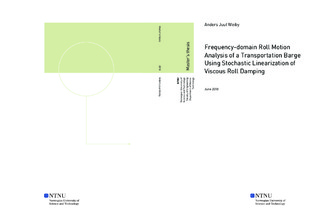| dc.description.abstract | This thesis is proposed by DNV GL, and presents a comparative study of frequency-domain and time-domain analysis of the roll motion. The goal is to perform a roll motion analysis of a barge-cargo system considering linearized roll damping with application of the stochastic linearization method.
Transportation of large structures causes fatigue damage on the structure. This is due to horizontal acceleration on deck caused by the damping, mainly due to the roll motion. To reduce the roll motion a bilge keel is found to be the most effective mechanism, it reduces the roll motion very well in both zero- and non-zero forward speed. Viscous damping from Eddy-making and bilge keel is found to be the most dominant damping contributions for the barge.
The equation of motion in both frequency domain and time domain are es- tablished, and a linearization of the non-linear damping term for roll motion is estimated. Linearity is a requirement when analyzing a problem in frequency domain. The linear equivalent damping term is established for both regular and irregular waves. The principle of equivalent linearization is used, where the energy loss of the equivalent damping shall be the same as the real energy loss per roll cycle.
The roll motion analysis is performed in HydroD/WADAM, where both regular and irregular waves are considered with 45 and 90 degrees wave heading. The quadratic damping is included as fraction of critical quadratic damping, and lin- earized by the stochastic linearization method. For the irregular wave case, the response spectrum obtained in the frequency domain analysis is compared with results from the time-domain analysis. The results from the frequency-domain analysis is good, and coincide very well with the results from the time-domain analysis, and creates a good basis for a transportation fatigue analysis. | |

